Despite being so familiar with Romeo and Juliet’s plot-line through not only reading Shakespeare itself but also its frequent appearances in literature and media, Act 4 Scene 1 still remains as one of my favorite scenes in Shakespeare’s plays as it highlights key aspects of Juliet’s character which is easily overshadowed by Romeo and Juliet’s tragic love story. This scene effectively displays Juliet’s charisma and wit as she sarcastically deflects all of Paris’ slimy courting whilst simultaneously displaying her impulsiveness and determination in willing to anything to be with her true lover, Romeo. Although Franco Zeffirelli’s Romeo and Juliet (1968) does a better job in depicting Juliet’s sarcasm in the first portion of the scene, I think Baz Luhrmann’s Romeo and Juliet (1996) is able to better demonstrate Juliet’s strong resolve in the latter portion of this scene.
In Zeffirelli’s Romeo + Juliet (1968), the scene begins with a short conversation between Paris and Friar Laurence about Juliet. Their conversation is interrupted by the sound of someone stomping down the stairs, emphasizing Juliet’s impatience. As Juliet enters the shot, the dark lighting only reveals her silhouette. When her face is finally caught in a head shot, she is shown wearing a veil,
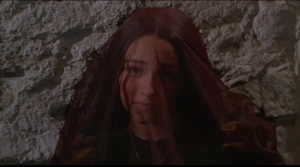
which serves as both a physical and emotional barrier separating her from Paris. Despite that the dark lighting and veil cover Juliet’s face, and despite the fact that Zeffirelli cuts a lot of the dialogue between Paris and Juliet, Olivia Hussey’s acting is able to clearly portray Juliet’s distaste for Paris. As with her sassy facial expression, Hussey’s tone as Juliet replies to Paris, “That may be, sir, when I may be a wife,” (IV.19) is also very sarcastic, which further highlights Juliet’s wit.
Similarly, in Luhrmann’s Romeo + Juliet, the scene begins with Paris discussing his problems with Juliet to Friar Laurence. However, in Luhrmann’s adaptation, their conversation is cut short by the opening of a door instead of the stomping in Zeffirelli’s adaptation which take away from Juliet being depicted as impatient. Also, in contrast to Hussey, Claire Danes is less dramatic in conveying
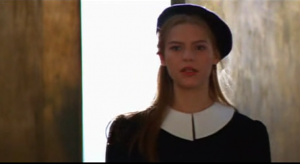
Juliet’s emotions through facial expressions. Despite that more of Shakespeare’s lines are employed in Luhrmann’s adaptation, the same line, “That may be, sir, when I may be a wife,” (IV.19) is stated rather plainly, and Juliet mainly shown as disinterested in Paris rather than sarcastic and witty. Danes’ depiction of Juliet in the beginning portion of this scene can be described as rather dull, as even her tone of voice does not encompass much sarcasm.
Yet in the latter portion of the scene as Juliet is alone conversing with Friar Laurence, Zeffirelli’s depiction of Juliet’s character seems slightly oversimplified. Excluding close up shots, Juliet is almost always shot at a slightly high angle shot. Additionally, Hussey’s expressive acting becomes a little too dramatic; even beginning with the wail of despair, “Oh, shut the door!” (IV.44). Juliet is then further seen sobbing, collapsed on the floor and clinging onto the table while her facial expression changes to display multiple array of emotions. This simplifies her character to a simply immature and emotional young girl who is powerless to solve these obstacles herself.
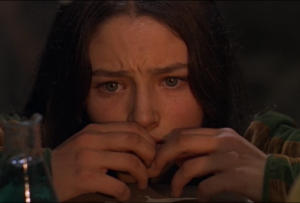
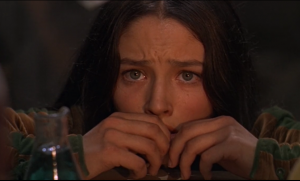
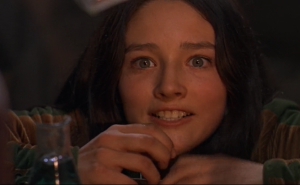
In Luhrmann’s adaptation, however, Juliet’s character is portrayed in more depth, as she is shown to be not only impulsive and emotional, but determined and courageous to do whatever is required of her to prevent herself from marrying Paris. Even from the beginning of this portion of the scene, the same line, “Oh, shut the door!” (IV.44) is said with much more frustration than despair. Also, Luhrmann’s modernization of Romeo and Juliet becomes most effective here, as Juliet is holding a gun to her head, threatening to take her own life. This shows the extent as to how much Juliet iscommitted to her desires.
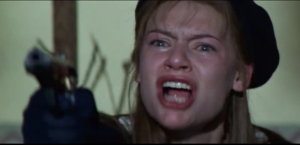
Dane’s acting becomes more dynamic, and one facial expression is able to encompass multiple emotions at once. Additionally, Juliet’s voice is more controlling and demanding, rather than “whiny” as depicted by Hussey in Zeffirelli’s Romeo and Juliet. Using more of Shakespeare’s lines also benefits Luhrmann’s portrayal of Juliet as it explicitly explains Juliet’s thoughts and state of mind.
Although, I do believe that Luhrmann’s adaptation of Shakespeare’s Romeo and Juliet was able to more dynamically portray Juliet as a character more than simply an emotional and immature girl, Zeffirelli’s adaptation had its own strengths in better depicting Juliet’s wit and sarcasm. However, conclusively, despite the various strengths that each film adaptation has, I believe that neither versions of this scene, nor any other film adaptations that had been created will be able to exceed Shakespeare’s original characterization of Juliet through the lines he explicitly writes in his play himself.
Leave a Reply
You must be logged in to post a comment.